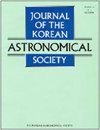The Contribution of Stellar Winds to Cosmic Ray Production
IF 0.8
4区 物理与天体物理
Q3 ASTRONOMY & ASTROPHYSICS
引用次数: 19
Abstract
Massive stars blow powerful stellar winds throughout their evolutionary stages from the main sequence to Wolf-Rayet phases. The amount of mechanical energy deposited in the interstellar medium by the wind from a massive star can be comparable to the explosion energy of a core-collapse supernova that detonates at the end of its life. In this study, we estimate the kinetic energy deposition by massive stars in our Galaxy by considering the integrated Galactic initial mass function and modeling the stellar wind luminosity. The mass loss rate and terminal velocity of stellar winds during the main sequence, red supergiant, and Wolf-Rayet stages are estimated by adopting theoretical calculations and observational data published in the literature. We find that the total stellar wind luminosity due to all massive stars in the Galaxy is about $L_w\approx 1.1\times 10^{41}$ erg/s, which is about 1/4 of the power of supernova explosions, $L_{SN} \approx 4.8\times 10^{41}$ erg/s. If we assume that $\sim 1-10$ % of the wind luminosity could be converted to Galactic cosmic rays (GCRs) through collisonless shocks such as termination shocks in stellar bubbles and superbubbles, colliding-wind shocks in binaries, and bow-shocks of massive runaway stars, stellar winds might be expected to make a significant contribution to GCR production, though lower than that of supernova remnants.恒星风对宇宙射线产生的贡献
大质量恒星在从主序到Wolf-Rayet相的整个进化阶段都会吹出强大的恒星风。大质量恒星的风在星际介质中沉积的机械能可以与在其生命末期引爆的核心坍塌超新星的爆炸能量相媲美。在这项研究中,我们通过考虑银河系的初始质量函数和恒星风光度模型来估计银河系中大质量恒星的动能沉积。采用理论计算和文献中发表的观测数据,估计了主序、红超巨星和Wolf-Rayet阶段恒星风的质量损失率和终端速度。我们发现,银河系中所有大质量恒星的恒星风总光度约为$L_w\约1.1\乘以10^{41}$erg/s,约为超新星爆炸功率的1/4,$L_{SN}约4.8\乘以10^{41}$erg/s。如果我们假设$\sim 1-10$%的风光度可以通过无碰撞冲击(如恒星气泡和超级气泡中的终止冲击、双星中的碰撞风冲击和大质量失控恒星的弓形冲击)转化为银河宇宙线(GCR),那么恒星风可能会对GCR的产生做出重大贡献,尽管低于超新星遗迹的水平。
本文章由计算机程序翻译,如有差异,请以英文原文为准。
求助全文
约1分钟内获得全文
求助全文
来源期刊

Journal of the Korean Astronomical Society
地学天文-天文与天体物理
CiteScore
1.30
自引率
10.00%
发文量
0
审稿时长
>12 weeks
期刊介绍:
JKAS is an international scientific journal publishing papers in all fields of astronomy and astrophysics. All manuscripts are subject to the scrutiny of referees. Manuscripts submitted to JKAS must comply with the ethics policy of JKAS. Six regular issues are published each year on February 28, April 30, June 30, August 31, October 31, and December 31. One year''s issues compose one volume.
 求助内容:
求助内容: 应助结果提醒方式:
应助结果提醒方式:


